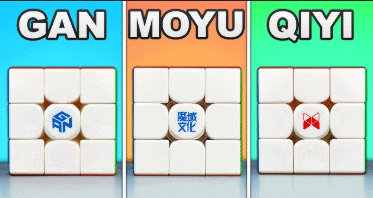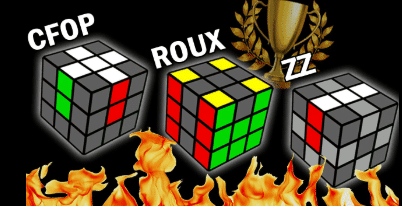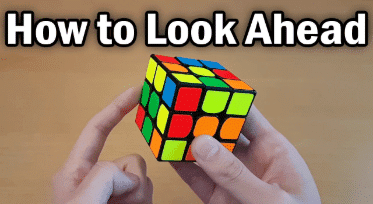Worksheet Solutions: Tips and Tricks | Solve Like a Pro: Rubik Cube Tutorials - Class 6 PDF Download
Multiple Choice Questions (MCQs)
Why do speedcubers prefer cubes from brands like MoYu, GAN, and QiYi over Rubik’s brand cubes?
(a) They are easier to scramble
(b) They have better corner-cutting and smooth rotation
(c) They are more colorful
(d) They are bigger in size
Ans: (b) They have better corner-cutting and smooth rotation
Explanation: These cubes are designed for speed, making it easier to execute finger tricks efficiently.
Which finger is commonly used to execute U moves in speedcubing?
(a) Thumb
(b) Index finger
(c) Middle finger
(d) Ring finger
Ans: (b) Index finger
Explanation: The index finger is used to push the U layer in the required direction for a fast and fluid solve.What is the primary reason why beginners experience pauses between moves?
(a) The cube is too fast
(b) They do not know enough algorithms
(c) They lack lookahead skills
(d) They are solving the cube with one hand
Ans: (c) They lack lookahead skills
Explanation: Lookahead helps predict the next move while executing the current one, reducing pauses.What is the most efficient way to perform a D move in speedcubing?
(a) Use the entire hand to rotate the bottom layer
(b) Use the thumb to push the layer
(c) Use the ring or pinky finger to push the layer
(d) Rotate the entire cube first
Ans: (c) Use the ring or pinky finger to push the layer
Explanation: Using the ring or pinky finger allows for minimal movement and prevents unnecessary cube rotations.Which of the following is NOT a commonly used advanced solving method?
(a) CFOP
(b) Roux
(c) ZZ
(d) Tetris Method
Ans: (d) Tetris Method
Explanation: The CFOP, Roux, and ZZ methods are advanced cubing techniques, while the "Tetris Method" does not exist in cubing.
True or False
True or False: Using a Rubik’s brand cube is the best option for speedcubing.
Ans: False
Explanation: Rubik’s brand cubes are not designed for speedcubing, as they have poor corner cutting and stiff turning.True or False: The best way to perform B moves in speedcubing is to rotate the cube so that B becomes U and then execute the move as a U move.
Ans: True
Explanation: Since B moves are difficult to perform directly, rotating the cube to turn B into U simplifies execution.True or False: The CFOP method is primarily used for solving the Pyraminx.
Ans: False
Explanation: The CFOP method is a speedcubing method for the 3x3 Rubik’s Cube, not the Pyraminx.True or False: Lookahead is the ability to anticipate the next move while executing the current one.
Ans: True
Explanation: Lookahead helps reduce pauses and speeds up the solving process by predicting the next move in advance.True or False: Advanced speedcubers prefer solving the cube layer by layer instead of block-building methods.
Ans: False
Explanation: Many advanced speedcubers prefer block-building methods like Roux or ZZ, which reduce unnecessary cube rotations.
Fill in the Blanks
The most important aspect of speedcubing after learning algorithms is mastering __________.
Ans: Finger tricks
Explanation: Finger tricks help execute moves faster, allowing for smoother and more efficient solves.The recommended brands for speedcubes include MoYu, GAN, QiYi, and __________.
Ans: YJ
Explanation: These brands manufacture high-quality speedcubes with smooth rotation, making them ideal for speedcubing.The process of planning the next move while executing the current move is known as __________.
Ans: Lookahead
Explanation: Lookahead helps minimize pauses and ensures a fluid solving experience.
The __________ method is the most widely used speedcubing method, consisting of Cross, F2L, OLL, and PLL.
Ans: CFOP
Explanation: CFOP (Cross, F2L, OLL, PLL) is the most popular method among speedcubers due to its efficiency.The best way to improve solving speed is to practice slow solving, __________ drills, and timed solves.
Ans: Algorithm
Explanation: Algorithm drills help speedcubers execute sequences faster and more efficiently through repeated practice.
|
23 videos|24 docs
|
FAQs on Worksheet Solutions: Tips and Tricks - Solve Like a Pro: Rubik Cube Tutorials - Class 6
| 1. What are some effective strategies for tackling multiple-choice questions in exams? |  |
| 2. How can I prepare for True or False questions effectively? |  |
| 3. What are the best practices for filling in the blanks in assessments? |  |
| 4. How can I improve my performance on worksheets that include tips and tricks? |  |
| 5. What common mistakes should I avoid during exams to ensure better results? |  |














